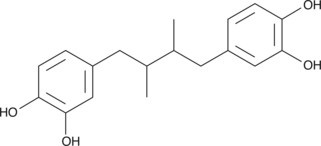Chemicals
Showing 29551–29700 of 41137 results
-
NDGA is a non-selective lipoxygenase (LO) inhibitor which blocks cysteinyl leukotriene (CysLT) synthesis. NDGA inhibits A-23187-induced CysLT biosynthesis in rat peritoneal cells with an IC50 value of 5-7 µM.{346} The IC50 values are 3.0-5.0 µM for human platelet 12-LO and 0.91 µM for rabbit reticulocyte 15-LO.{346,1710}
Brand:CaymanSKU:70300 - 1 gAvailable on backorder
NDGA is a non-selective lipoxygenase (LO) inhibitor which blocks cysteinyl leukotriene (CysLT) synthesis. NDGA inhibits A-23187-induced CysLT biosynthesis in rat peritoneal cells with an IC50 value of 5-7 µM.{346} The IC50 values are 3.0-5.0 µM for human platelet 12-LO and 0.91 µM for rabbit reticulocyte 15-LO.{346,1710}
Brand:CaymanSKU:70300 - 5 gAvailable on backorder
NDGA is a non-selective lipoxygenase (LO) inhibitor which blocks cysteinyl leukotriene (CysLT) synthesis. NDGA inhibits A-23187-induced CysLT biosynthesis in rat peritoneal cells with an IC50 value of 5-7 µM.{346} The IC50 values are 3.0-5.0 µM for human platelet 12-LO and 0.91 µM for rabbit reticulocyte 15-LO.{346,1710}
Brand:CaymanSKU:70300 - 500 mgAvailable on backorder
Norethindrone is a synthetic progesterone (Item No. 15876) of the 19-nortestosterone class with similar effects to those of natural progesterone via activation of the progesterone receptor. It is reported to stimulate the growth of estrogen receptor (ER)-positive but not ER-negative breast cancer cells in culture.{32954}
Brand:CaymanSKU:20941 -Out of stock
Norethindrone is a synthetic progesterone (Item No. 15876) of the 19-nortestosterone class with similar effects to those of natural progesterone via activation of the progesterone receptor. It is reported to stimulate the growth of estrogen receptor (ER)-positive but not ER-negative breast cancer cells in culture.{32954}
Brand:CaymanSKU:20941 -Out of stock
Norethindrone is a synthetic progesterone (Item No. 15876) of the 19-nortestosterone class with similar effects to those of natural progesterone via activation of the progesterone receptor. It is reported to stimulate the growth of estrogen receptor (ER)-positive but not ER-negative breast cancer cells in culture.{32954}
Brand:CaymanSKU:20941 -Out of stock
Norethindrone is a synthetic progesterone (Item No. 15876) of the 19-nortestosterone class with similar effects to those of natural progesterone via activation of the progesterone receptor. It is reported to stimulate the growth of estrogen receptor (ER)-positive but not ER-negative breast cancer cells in culture.{32954}
Brand:CaymanSKU:20941 -Out of stock
Norfloxacin is a fluoroquinolone antibiotic that inhibits the growth of Gram-positive and Gram-negative bacteria (MICs = 4 and 1 μg/ml for S. aureus and P. aeruginosa, respectively).{45096} It also inhibits the growth S. pseudintermedius, S. aureus, E. coli, Pasturella, and S. canis isolates from dogs (mean MIC50s = 0.25, 1, 0.03, 1, and 1 μg/ml, respectively).{39898} Topical administration of norfloxacin (0.1% v/v) reduces corneal ulcer size in a rabbit model of P. aeruginosa corneal infection. It also prevents encrusted cystitis in bladder and increases survival in a rat model of Corynebacterium group D2 infection when administered at a dose of 80 mg/kg per day.{45097} Formulations containing norfloxacin have been used to treat urinary tract and gynecological infections.
Brand:CaymanSKU:25975 - 10 gAvailable on backorder
Norfloxacin is a fluoroquinolone antibiotic that inhibits the growth of Gram-positive and Gram-negative bacteria (MICs = 4 and 1 μg/ml for S. aureus and P. aeruginosa, respectively).{45096} It also inhibits the growth S. pseudintermedius, S. aureus, E. coli, Pasturella, and S. canis isolates from dogs (mean MIC50s = 0.25, 1, 0.03, 1, and 1 μg/ml, respectively).{39898} Topical administration of norfloxacin (0.1% v/v) reduces corneal ulcer size in a rabbit model of P. aeruginosa corneal infection. It also prevents encrusted cystitis in bladder and increases survival in a rat model of Corynebacterium group D2 infection when administered at a dose of 80 mg/kg per day.{45097} Formulations containing norfloxacin have been used to treat urinary tract and gynecological infections.
Brand:CaymanSKU:25975 - 25 gAvailable on backorder
Norfloxacin is a fluoroquinolone antibiotic that inhibits the growth of Gram-positive and Gram-negative bacteria (MICs = 4 and 1 μg/ml for S. aureus and P. aeruginosa, respectively).{45096} It also inhibits the growth S. pseudintermedius, S. aureus, E. coli, Pasturella, and S. canis isolates from dogs (mean MIC50s = 0.25, 1, 0.03, 1, and 1 μg/ml, respectively).{39898} Topical administration of norfloxacin (0.1% v/v) reduces corneal ulcer size in a rabbit model of P. aeruginosa corneal infection. It also prevents encrusted cystitis in bladder and increases survival in a rat model of Corynebacterium group D2 infection when administered at a dose of 80 mg/kg per day.{45097} Formulations containing norfloxacin have been used to treat urinary tract and gynecological infections.
Brand:CaymanSKU:25975 - 5 gAvailable on backorder
Norfloxacin is a fluoroquinolone antibiotic that inhibits the growth of Gram-positive and Gram-negative bacteria (MICs = 4 and 1 μg/ml for S. aureus and P. aeruginosa, respectively).{45096} It also inhibits the growth S. pseudintermedius, S. aureus, E. coli, Pasturella, and S. canis isolates from dogs (mean MIC50s = 0.25, 1, 0.03, 1, and 1 μg/ml, respectively).{39898} Topical administration of norfloxacin (0.1% v/v) reduces corneal ulcer size in a rabbit model of P. aeruginosa corneal infection. It also prevents encrusted cystitis in bladder and increases survival in a rat model of Corynebacterium group D2 infection when administered at a dose of 80 mg/kg per day.{45097} Formulations containing norfloxacin have been used to treat urinary tract and gynecological infections.
Brand:CaymanSKU:25975 - 50 gAvailable on backorder
Norfloxacin-d5 is intended for use as an internal standard for the quantification of norfloxacin (Item No. 25975) by GC- or LC-MS. Norfloxacin is a fluoroquinolone antibiotic that inhibits the growth of Gram-positive and Gram-negative bacteria (MICs = 4 and 1 μg/ml for S. aureus and P. aeruginosa, respectively).{45096} It also inhibits the growth S. pseudintermedius, S. aureus, E. coli, Pasturella, and S. canis isolates from dogs (mean MIC50s = 0.25, 1, 0.03, 1, and 1 μg/ml, respectively).{39898} Topical administration of norfloxacin (0.1% v/v) reduces corneal ulcer size in a rabbit model of P. aeruginosa corneal infection. It also prevents encrusted cystitis in bladder and increases survival in a rat model of Corynebacterium group D2 infection when administered at a dose of 80 mg/kg per day.{45097} Formulations containing norfloxacin have been used to treat urinary tract and gynecological infections.
Brand:CaymanSKU:28521 - 1 mgAvailable on backorder
Norfloxacin-d5 is intended for use as an internal standard for the quantification of norfloxacin (Item No. 25975) by GC- or LC-MS. Norfloxacin is a fluoroquinolone antibiotic that inhibits the growth of Gram-positive and Gram-negative bacteria (MICs = 4 and 1 μg/ml for S. aureus and P. aeruginosa, respectively).{45096} It also inhibits the growth S. pseudintermedius, S. aureus, E. coli, Pasturella, and S. canis isolates from dogs (mean MIC50s = 0.25, 1, 0.03, 1, and 1 μg/ml, respectively).{39898} Topical administration of norfloxacin (0.1% v/v) reduces corneal ulcer size in a rabbit model of P. aeruginosa corneal infection. It also prevents encrusted cystitis in bladder and increases survival in a rat model of Corynebacterium group D2 infection when administered at a dose of 80 mg/kg per day.{45097} Formulations containing norfloxacin have been used to treat urinary tract and gynecological infections.
Brand:CaymanSKU:28521 - 10 mgAvailable on backorder
Norfloxacin-d5 is intended for use as an internal standard for the quantification of norfloxacin (Item No. 25975) by GC- or LC-MS. Norfloxacin is a fluoroquinolone antibiotic that inhibits the growth of Gram-positive and Gram-negative bacteria (MICs = 4 and 1 μg/ml for S. aureus and P. aeruginosa, respectively).{45096} It also inhibits the growth S. pseudintermedius, S. aureus, E. coli, Pasturella, and S. canis isolates from dogs (mean MIC50s = 0.25, 1, 0.03, 1, and 1 μg/ml, respectively).{39898} Topical administration of norfloxacin (0.1% v/v) reduces corneal ulcer size in a rabbit model of P. aeruginosa corneal infection. It also prevents encrusted cystitis in bladder and increases survival in a rat model of Corynebacterium group D2 infection when administered at a dose of 80 mg/kg per day.{45097} Formulations containing norfloxacin have been used to treat urinary tract and gynecological infections.
Brand:CaymanSKU:28521 - 5 mgAvailable on backorder
Norfluoxetine is an active metabolite of the antidepressant fluoxetine that inhibits serotonin uptake with a pKi value of 7.35.{25776} The S-enantiomer of norfluoxetine has 20-times higher serotonin reuptake blocking potency than the R-enantiomer (pKis = 7.86 versus 6.51, respectively).{25777,25776}
Brand:CaymanSKU:-Norfluoxetine is an active metabolite of the antidepressant fluoxetine that inhibits serotonin uptake with a pKi value of 7.35.{25776} The S-enantiomer of norfluoxetine has 20-times higher serotonin reuptake blocking potency than the R-enantiomer (pKis = 7.86 versus 6.51, respectively).{25777,25776}
Brand:CaymanSKU:-Norfluoxetine is an active metabolite of the antidepressant fluoxetine that inhibits serotonin uptake with a pKi value of 7.35.{25776} The S-enantiomer of norfluoxetine has 20-times higher serotonin reuptake blocking potency than the R-enantiomer (pKis = 7.86 versus 6.51, respectively).{25777,25776}
Brand:CaymanSKU:-Norgestimate is a progestin and a prodrug form of norelgestromin and levonorgestrel (Item No. 10006318).{53982,12452} It binds to progestin receptors (mean IC50 = 3.48 nM for rabbit uterine receptors) and is selective for progestin over androgen receptors (mean IC50 = 764 nM for rat prostatic receptors) in radioligand binding assays.{53983} Norgestimate maintains pregnancy in ovariectomized female rats in a dose-dependent manner.{53982} It inhibits ovulation in 100% of female rats when administered at a dose of 0.5 mg/kg. Norgestimate (2 mg/kg) completely inhibits estrone-induced vaginal cornification in ovariectomized female rats, indicating antiestrogenic activity. Formulations containing norgestimate in combination with ethinyl estradiol have been used as oral contraceptives and in the treatment of acne vulgaris.
Brand:CaymanSKU:-Out of stock
Norgestimate is a progestin and a prodrug form of norelgestromin and levonorgestrel (Item No. 10006318).{53982,12452} It binds to progestin receptors (mean IC50 = 3.48 nM for rabbit uterine receptors) and is selective for progestin over androgen receptors (mean IC50 = 764 nM for rat prostatic receptors) in radioligand binding assays.{53983} Norgestimate maintains pregnancy in ovariectomized female rats in a dose-dependent manner.{53982} It inhibits ovulation in 100% of female rats when administered at a dose of 0.5 mg/kg. Norgestimate (2 mg/kg) completely inhibits estrone-induced vaginal cornification in ovariectomized female rats, indicating antiestrogenic activity. Formulations containing norgestimate in combination with ethinyl estradiol have been used as oral contraceptives and in the treatment of acne vulgaris.
Brand:CaymanSKU:-Out of stock
Norgestimate is a progestin and a prodrug form of norelgestromin and levonorgestrel (Item No. 10006318).{53982,12452} It binds to progestin receptors (mean IC50 = 3.48 nM for rabbit uterine receptors) and is selective for progestin over androgen receptors (mean IC50 = 764 nM for rat prostatic receptors) in radioligand binding assays.{53983} Norgestimate maintains pregnancy in ovariectomized female rats in a dose-dependent manner.{53982} It inhibits ovulation in 100% of female rats when administered at a dose of 0.5 mg/kg. Norgestimate (2 mg/kg) completely inhibits estrone-induced vaginal cornification in ovariectomized female rats, indicating antiestrogenic activity. Formulations containing norgestimate in combination with ethinyl estradiol have been used as oral contraceptives and in the treatment of acne vulgaris.
Brand:CaymanSKU:-Out of stock
Norgestimate is a progestin and a prodrug form of norelgestromin and levonorgestrel (Item No. 10006318).{53982,12452} It binds to progestin receptors (mean IC50 = 3.48 nM for rabbit uterine receptors) and is selective for progestin over androgen receptors (mean IC50 = 764 nM for rat prostatic receptors) in radioligand binding assays.{53983} Norgestimate maintains pregnancy in ovariectomized female rats in a dose-dependent manner.{53982} It inhibits ovulation in 100% of female rats when administered at a dose of 0.5 mg/kg. Norgestimate (2 mg/kg) completely inhibits estrone-induced vaginal cornification in ovariectomized female rats, indicating antiestrogenic activity. Formulations containing norgestimate in combination with ethinyl estradiol have been used as oral contraceptives and in the treatment of acne vulgaris.
Brand:CaymanSKU:-Out of stock
Norgestimate-d6 is intended for use as an internal standard for the quantification of norgestimate (Item No. 16547) by GC- or LC-MS. Norgestimate is a progestin and a prodrug form of norelgestromin and levonorgestrel (Item No. 10006318).{53982,12452} It binds to progestin receptors (mean IC50 = 3.48 nM for rabbit uterine receptors) and is selective for progestin over androgen receptors (mean IC50 = 764 nM for rat prostatic receptors) in radioligand binding assays.{53983} Norgestimate maintains pregnancy in ovariectomized female rats in a dose-dependent manner.{53982} It inhibits ovulation in 100% of female rats when administered at a dose of 0.5 mg/kg. Norgestimate (2 mg/kg) completely inhibits estrone-induced vaginal cornification in ovariectomized female rats, indicating antiestrogenic activity. Formulations containing norgestimate in combination with ethinyl estradiol have been used as oral contraceptives and in the treatment of acne vulgaris.
Brand:CaymanSKU:31176 - 1 mgAvailable on backorder
Norgestimate-d6 is intended for use as an internal standard for the quantification of norgestimate (Item No. 16547) by GC- or LC-MS. Norgestimate is a progestin and a prodrug form of norelgestromin and levonorgestrel (Item No. 10006318).{53982,12452} It binds to progestin receptors (mean IC50 = 3.48 nM for rabbit uterine receptors) and is selective for progestin over androgen receptors (mean IC50 = 764 nM for rat prostatic receptors) in radioligand binding assays.{53983} Norgestimate maintains pregnancy in ovariectomized female rats in a dose-dependent manner.{53982} It inhibits ovulation in 100% of female rats when administered at a dose of 0.5 mg/kg. Norgestimate (2 mg/kg) completely inhibits estrone-induced vaginal cornification in ovariectomized female rats, indicating antiestrogenic activity. Formulations containing norgestimate in combination with ethinyl estradiol have been used as oral contraceptives and in the treatment of acne vulgaris.
Brand:CaymanSKU:31176 - 500 µgAvailable on backorder
Norgestrel is a synthetic progestin and a racemic mixture of dextronorgestrel and levonorgestrel (Item No. 10006318), of which levonorgestrel is the biologically active component.{39728} In vivo, norgestrel administered via intrauterine device (IUD) prevents pregnancy in rats.{39733} Formulations containing nogestrel have been used as contraceptives.
Brand:CaymanSKU:10006319 - 1 gAvailable on backorder
Norgestrel is a synthetic progestin and a racemic mixture of dextronorgestrel and levonorgestrel (Item No. 10006318), of which levonorgestrel is the biologically active component.{39728} In vivo, norgestrel administered via intrauterine device (IUD) prevents pregnancy in rats.{39733} Formulations containing nogestrel have been used as contraceptives.
Brand:CaymanSKU:10006319 - 100 mgAvailable on backorder
Norgestrel is a synthetic progestin and a racemic mixture of dextronorgestrel and levonorgestrel (Item No. 10006318), of which levonorgestrel is the biologically active component.{39728} In vivo, norgestrel administered via intrauterine device (IUD) prevents pregnancy in rats.{39733} Formulations containing nogestrel have been used as contraceptives.
Brand:CaymanSKU:10006319 - 5 gAvailable on backorder
Norgestrel is a synthetic progestin and a racemic mixture of dextronorgestrel and levonorgestrel (Item No. 10006318), of which levonorgestrel is the biologically active component.{39728} In vivo, norgestrel administered via intrauterine device (IUD) prevents pregnancy in rats.{39733} Formulations containing nogestrel have been used as contraceptives.
Brand:CaymanSKU:10006319 - 500 mgAvailable on backorder
Norharmane is a natural β-carboline first isolated from plants of the Zygophyllaceae family. It is a heterocyclic amine that may also be found in fried meats, tobacco smoke, and coffee.{32208,32210} While not mutagenic by itself, norharmane is described as a co-mutagen, as it induces or enhances the mutagenicity of other compounds, commonly forming DNA adducts.{32209}
Brand:CaymanSKU:20043 -Available on backorder
Norharmane is a natural β-carboline first isolated from plants of the Zygophyllaceae family. It is a heterocyclic amine that may also be found in fried meats, tobacco smoke, and coffee.{32208,32210} While not mutagenic by itself, norharmane is described as a co-mutagen, as it induces or enhances the mutagenicity of other compounds, commonly forming DNA adducts.{32209}
Brand:CaymanSKU:20043 -Available on backorder
Norharmane is a natural β-carboline first isolated from plants of the Zygophyllaceae family. It is a heterocyclic amine that may also be found in fried meats, tobacco smoke, and coffee.{32208,32210} While not mutagenic by itself, norharmane is described as a co-mutagen, as it induces or enhances the mutagenicity of other compounds, commonly forming DNA adducts.{32209}
Brand:CaymanSKU:20043 -Available on backorder
Norharmane is a natural β-carboline first isolated from plants of the Zygophyllaceae family. It is a heterocyclic amine that may also be found in fried meats, tobacco smoke, and coffee.{32208,32210} While not mutagenic by itself, norharmane is described as a co-mutagen, as it induces or enhances the mutagenicity of other compounds, commonly forming DNA adducts.{32209}
Brand:CaymanSKU:20043 -Available on backorder
Norhyodeoxycholic acid (NHDCA) is a synthetic bile acid and a derivative of hyodeoxycholic acid (HDCA; Item No. 20294).{53355,53356} NHDCA is an intermediate in the synthesis of 3β-sulfooxy-7β-hydroxy-24-nor-5-cholen-23-oic acid, which has been used as an internal standard for the quantification of Δ5-bile acid conjugates that have been identified in patients with Niemann-Pick disease type C1.{53357}
Brand:CaymanSKU:9003440 - 1 mgAvailable on backorder
Norhyodeoxycholic acid (NHDCA) is a synthetic bile acid and a derivative of hyodeoxycholic acid (HDCA; Item No. 20294).{53355,53356} NHDCA is an intermediate in the synthesis of 3β-sulfooxy-7β-hydroxy-24-nor-5-cholen-23-oic acid, which has been used as an internal standard for the quantification of Δ5-bile acid conjugates that have been identified in patients with Niemann-Pick disease type C1.{53357}
Brand:CaymanSKU:9003440 - 10 mgAvailable on backorder
Norhyodeoxycholic acid (NHDCA) is a synthetic bile acid and a derivative of hyodeoxycholic acid (HDCA; Item No. 20294).{53355,53356} NHDCA is an intermediate in the synthesis of 3β-sulfooxy-7β-hydroxy-24-nor-5-cholen-23-oic acid, which has been used as an internal standard for the quantification of Δ5-bile acid conjugates that have been identified in patients with Niemann-Pick disease type C1.{53357}
Brand:CaymanSKU:9003440 - 5 mgAvailable on backorder
Nornidulin is a depsidone originally isolated from A. nidulans that has antibacterial activity against M. tuberculosis and M. ranoe as well as antifungal activity against T. tonsurans and M. audouini.{38475} It also inhibits the growth of methicillin-resistant S. aureus (MRSA; MIC = 2 µg/ml) and has larvicidal activity toward Artemia (LC50 = 1.7 µg/ml).{38476} Nornidulin has cytotoxic activity in MOLT-3 cells (IC50 = 35.7 µM) but not HuCCA-1, HepG2, or A549 cells (IC50s = >116.4 µM).{38477}
Brand:CaymanSKU:23646 - 1 mgAvailable on backorder
Nornidulin is a depsidone originally isolated from A. nidulans that has antibacterial activity against M. tuberculosis and M. ranoe as well as antifungal activity against T. tonsurans and M. audouini.{38475} It also inhibits the growth of methicillin-resistant S. aureus (MRSA; MIC = 2 µg/ml) and has larvicidal activity toward Artemia (LC50 = 1.7 µg/ml).{38476} Nornidulin has cytotoxic activity in MOLT-3 cells (IC50 = 35.7 µM) but not HuCCA-1, HepG2, or A549 cells (IC50s = >116.4 µM).{38477}
Brand:CaymanSKU:23646 - 5 mgAvailable on backorder
Norstictic acid is a lichen metabolite that has been found in R. farinacea and has antimicrobial and anticancer activities.{48720,48721} It is active against A. hydrophilia, B. subtilis, L. monocytogenes, P. vulgaris, S. faecalis, C. albicans, and C. glabrata (MICs = 0.1-6.7 mM).{48720} Norstictic acid (1-100 μM) inhibits proliferation, migration, and invasion of MDA-MB-231 cells.{48721} In vivo, norstictic acid (15 mg/kg, i.p.) reduces tumor growth in an MDA-MB-231/GFP mouse xenograft model.
Brand:CaymanSKU:29581 - 1 mgAvailable on backorder
Norstictic acid is a lichen metabolite that has been found in R. farinacea and has antimicrobial and anticancer activities.{48720,48721} It is active against A. hydrophilia, B. subtilis, L. monocytogenes, P. vulgaris, S. faecalis, C. albicans, and C. glabrata (MICs = 0.1-6.7 mM).{48720} Norstictic acid (1-100 μM) inhibits proliferation, migration, and invasion of MDA-MB-231 cells.{48721} In vivo, norstictic acid (15 mg/kg, i.p.) reduces tumor growth in an MDA-MB-231/GFP mouse xenograft model.
Brand:CaymanSKU:29581 - 5 mgAvailable on backorder
Sufentanil is a powerful synthetic opioid analgesic that is used in anesthesia and palliative care.{20880,20881,20882} Norsufentanil is a metabolite of sufentanil, produced by oxidative N-dealkylation in the liver by cytochrome P450 isoforms.{20868} The physiological and toxicological properties of this compound are unknown. This product is intended for forensic applications.
Brand:CaymanSKU:9001142 - 1 mgAvailable on backorder
Sufentanil is a powerful synthetic opioid analgesic that is used in anesthesia and palliative care.{20880,20881,20882} Norsufentanil is a metabolite of sufentanil, produced by oxidative N-dealkylation in the liver by cytochrome P450 isoforms.{20868} The physiological and toxicological properties of this compound are unknown. This product is intended for forensic applications.
Brand:CaymanSKU:9001142 - 10 mgAvailable on backorder
Sufentanil is a powerful synthetic opioid analgesic that is used in anesthesia and palliative care.{20880,20881,20882} Norsufentanil is a metabolite of sufentanil, produced by oxidative N-dealkylation in the liver by cytochrome P450 isoforms.{20868} The physiological and toxicological properties of this compound are unknown. This product is intended for forensic applications.
Brand:CaymanSKU:9001142 - 5 mgAvailable on backorder
Norsufentanil-d3 contains three deuterium atoms. It is intended for use as an internal standard for the quantification of norsufentanil by GC- or LC-mass spectrometry. Sufentanil is a powerful synthetic opioid analgesic that is used in anesthesia and palliative care.{20880,20881,20882} Norsufentanil is a metabolite of sufentanil, produced by oxidative N-dealkylation in the liver by cytochrome P450 isoforms.{20868} The physiological and toxicological properties of this compound are unknown. This product is intended for forensic applications.
Brand:CaymanSKU:9001143 - 1 mgAvailable on backorder
Norsufentanil-d3 contains three deuterium atoms. It is intended for use as an internal standard for the quantification of norsufentanil by GC- or LC-mass spectrometry. Sufentanil is a powerful synthetic opioid analgesic that is used in anesthesia and palliative care.{20880,20881,20882} Norsufentanil is a metabolite of sufentanil, produced by oxidative N-dealkylation in the liver by cytochrome P450 isoforms.{20868} The physiological and toxicological properties of this compound are unknown. This product is intended for forensic applications.
Brand:CaymanSKU:9001143 - 5 mgAvailable on backorder
Norsufentanil-d3 contains three deuterium atoms. It is intended for use as an internal standard for the quantification of norsufentanil by GC- or LC-mass spectrometry. Sufentanil is a powerful synthetic opioid analgesic that is used in anesthesia and palliative care.{20880,20881,20882} Norsufentanil is a metabolite of sufentanil, produced by oxidative N-dealkylation in the liver by cytochrome P450 isoforms.{20868} The physiological and toxicological properties of this compound are unknown. This product is intended for forensic applications.
Brand:CaymanSKU:9001143 - 500 µgAvailable on backorder
Nortriptyline is a tricyclic antidepressant that blocks norepinephrine and serotonin (Item No. 14332) transporters (KDs = 4.4 and 18 nM, respectively) more potently than the dopamine transporter (KD = 1.1 µM).{22877} It also antagonizes serotonin, histamine, muscarinic, and α-adrenergic receptors (Kis = 5.0, 8.5, 10, 40, and 60 nM for 5-HT2A, 5-HT2C, H1, α1, and M1 receptors, respectively).{25805,25914,25806,25803}
Brand:CaymanSKU:-Nortriptyline is a tricyclic antidepressant that blocks norepinephrine and serotonin (Item No. 14332) transporters (KDs = 4.4 and 18 nM, respectively) more potently than the dopamine transporter (KD = 1.1 µM).{22877} It also antagonizes serotonin, histamine, muscarinic, and α-adrenergic receptors (Kis = 5.0, 8.5, 10, 40, and 60 nM for 5-HT2A, 5-HT2C, H1, α1, and M1 receptors, respectively).{25805,25914,25806,25803}
Brand:CaymanSKU:-Nortriptyline is a tricyclic antidepressant that blocks norepinephrine and serotonin (Item No. 14332) transporters (KDs = 4.4 and 18 nM, respectively) more potently than the dopamine transporter (KD = 1.1 µM).{22877} It also antagonizes serotonin, histamine, muscarinic, and α-adrenergic receptors (Kis = 5.0, 8.5, 10, 40, and 60 nM for 5-HT2A, 5-HT2C, H1, α1, and M1 receptors, respectively).{25805,25914,25806,25803}
Brand:CaymanSKU:-Norverapamil is the N-demethylated metabolite of verapamil (Item No. 14288), an L-type calcium channel blocker and P-glycoprotein inhibitor. It is the major active metabolite of verapamil with approximately 20% efficacy of its parent with regard to vasodilatory activity.{32942} Norverapamil has been shown to inhibit mycobacterial efflux pumps and the expansion of M. tuberculosis-specific T cells.{32941}
Brand:CaymanSKU:20950 -Out of stock
Norverapamil is the N-demethylated metabolite of verapamil (Item No. 14288), an L-type calcium channel blocker and P-glycoprotein inhibitor. It is the major active metabolite of verapamil with approximately 20% efficacy of its parent with regard to vasodilatory activity.{32942} Norverapamil has been shown to inhibit mycobacterial efflux pumps and the expansion of M. tuberculosis-specific T cells.{32941}
Brand:CaymanSKU:20950 -Out of stock
Norverapamil is the N-demethylated metabolite of verapamil (Item No. 14288), an L-type calcium channel blocker and P-glycoprotein inhibitor. It is the major active metabolite of verapamil with approximately 20% efficacy of its parent with regard to vasodilatory activity.{32942} Norverapamil has been shown to inhibit mycobacterial efflux pumps and the expansion of M. tuberculosis-specific T cells.{32941}
Brand:CaymanSKU:20950 -Out of stock
Noscapine is an alkaloid that has been found in opium and has anticancer and antitussive properties.{28232,28233,49588} It binds to tubulin and induces cell cycle arrest at the G2/M phase in HeLa cells when used at a concentration of 20 µM.{28233} Noscapine induces apoptosis in HeLa cells and thymocytes (IC50s = 25 and 10 µM, respectively) and reduces proliferation of MCF-7 breast and Renal 1983 bladder cancer cells (IC50s = 42.3 and 39.1 µM, respectively). In vivo, noscapine (120 mg/kg) induces tumor regression in an MCF-7 mouse xenograft model. Noscapine (30 and 70 mg/kg) decreases the number of citric acid-induced coughs in guinea pigs.{49588}
Brand:CaymanSKU:-Out of stock
Noscapine is an alkaloid that has been found in opium and has anticancer and antitussive properties.{28232,28233,49588} It binds to tubulin and induces cell cycle arrest at the G2/M phase in HeLa cells when used at a concentration of 20 µM.{28233} Noscapine induces apoptosis in HeLa cells and thymocytes (IC50s = 25 and 10 µM, respectively) and reduces proliferation of MCF-7 breast and Renal 1983 bladder cancer cells (IC50s = 42.3 and 39.1 µM, respectively). In vivo, noscapine (120 mg/kg) induces tumor regression in an MCF-7 mouse xenograft model. Noscapine (30 and 70 mg/kg) decreases the number of citric acid-induced coughs in guinea pigs.{49588}
Brand:CaymanSKU:-Out of stock
Noscapine is an alkaloid that has been found in opium and has anticancer and antitussive properties.{28232,28233,49588} It binds to tubulin and induces cell cycle arrest at the G2/M phase in HeLa cells when used at a concentration of 20 µM.{28233} Noscapine induces apoptosis in HeLa cells and thymocytes (IC50s = 25 and 10 µM, respectively) and reduces proliferation of MCF-7 breast and Renal 1983 bladder cancer cells (IC50s = 42.3 and 39.1 µM, respectively). In vivo, noscapine (120 mg/kg) induces tumor regression in an MCF-7 mouse xenograft model. Noscapine (30 and 70 mg/kg) decreases the number of citric acid-induced coughs in guinea pigs.{49588}
Brand:CaymanSKU:-Out of stock
Noscapine-13C-d3 is intended for use as an internal standard for the quantification of noscapine (Item No. 17255) by GC- or LC-MS. Noscapine is an alkaloid that has been found in opium and has anticancer and antitussive properties.{28232,28233,49588} It binds to tubulin and induces cell cycle arrest at the G2/M phase in HeLa cells when used at a concentration of 20 µM.{28233} Noscapine induces apoptosis in HeLa cells and thymocytes (IC50s = 25 and 10 µM, respectively) and reduces proliferation of MCF-7 breast and Renal 1983 bladder cancer cells (IC50s = 42.3 and 39.1 µM, respectively). In vivo, noscapine (120 mg/kg) induces tumor regression in an MCF-7 mouse xenograft model. Noscapine (30 and 70 mg/kg) decreases the number of citric acid-induced coughs in guinea pigs.{49588}
Brand:CaymanSKU:26679 - 1 mgAvailable on backorder
Noscapine-13C-d3 is intended for use as an internal standard for the quantification of noscapine (Item No. 17255) by GC- or LC-MS. Noscapine is an alkaloid that has been found in opium and has anticancer and antitussive properties.{28232,28233,49588} It binds to tubulin and induces cell cycle arrest at the G2/M phase in HeLa cells when used at a concentration of 20 µM.{28233} Noscapine induces apoptosis in HeLa cells and thymocytes (IC50s = 25 and 10 µM, respectively) and reduces proliferation of MCF-7 breast and Renal 1983 bladder cancer cells (IC50s = 42.3 and 39.1 µM, respectively). In vivo, noscapine (120 mg/kg) induces tumor regression in an MCF-7 mouse xenograft model. Noscapine (30 and 70 mg/kg) decreases the number of citric acid-induced coughs in guinea pigs.{49588}
Brand:CaymanSKU:26679 - 500 µgAvailable on backorder
Nosiheptide is a thiopeptide antibiotic that inhibits bacterial protein synthesis by interfering with the function of elongation factors.{27776,27778} It is effective against many different methicillin-resistant S. aureus strains (MICs ≤ 0.25 mg/L), Enterococcus spp (MICs ≤ 0.125 mg/L), and the BI strain of C. difficile (MIC = 0.008 mg/L) but inactive against most Gram-negative bacteria.{27777}
Brand:CaymanSKU:-Out of stock
Nosiheptide is a thiopeptide antibiotic that inhibits bacterial protein synthesis by interfering with the function of elongation factors.{27776,27778} It is effective against many different methicillin-resistant S. aureus strains (MICs ≤ 0.25 mg/L), Enterococcus spp (MICs ≤ 0.125 mg/L), and the BI strain of C. difficile (MIC = 0.008 mg/L) but inactive against most Gram-negative bacteria.{27777}
Brand:CaymanSKU:-Out of stock
Notoginsenoside Ft1 is a saponin originally isolated from P. notoginseng with diverse biological activities.{37598,37599,37600,37601,37602} It induces proliferation, migration, and tube formation of human umbilical vein endothelial cells (HUVECs) via nuclear translocation of hypoxia-inducible factor-1α (HIF-1α) and activation of the PI3K/AKT and Raf/MEK/ERK signaling pathways in a manner dependent on mammalian target of rapamycin (mTOR).{37598} Notoginsenoside Ft1 (45 μM) induces cell cycle arrest at the S and G2/M phases and promotes apoptosis of SH-SY5Y cells.{37599} It increases cGMP levels and induces relaxation of isolated precontracted rat mesenteric arteries, effects that are reversed by the nitric oxide synthase inhibitor L-NAME (Item No. 80210) and ODQ (Item No. 81410), an inhibitor of soluble guanylyl cyclase.{37600} In vivo, notoginsenoside Ft1 (0.25, 2.5, and 25 mg/kg) promotes angiogenesis and decreases wound diameter in a mouse model of punched-hole ear injury.{37598} Notoginsenoside Ft1 (1.25 mg/kg) decreases tail bleeding time and increases thrombus weight in a rat tail bleeding assay.{37601} Topical administration of notoginsenoside Ft1 increases mRNA expression of the collagen expression, fibroblast proliferation, and scar formation genes COL1A1, COL3A1, TGF-β1, TGF-β3, and fibronectin, promotes neovascularization, reduces monocyte infiltration, and shortens wound closure time in a db/db mouse model of diabetic foot ulcers.{37602}
Brand:CaymanSKU:24976 - 1 mgAvailable on backorder
Notoginsenoside Ft1 is a saponin originally isolated from P. notoginseng with diverse biological activities.{37598,37599,37600,37601,37602} It induces proliferation, migration, and tube formation of human umbilical vein endothelial cells (HUVECs) via nuclear translocation of hypoxia-inducible factor-1α (HIF-1α) and activation of the PI3K/AKT and Raf/MEK/ERK signaling pathways in a manner dependent on mammalian target of rapamycin (mTOR).{37598} Notoginsenoside Ft1 (45 μM) induces cell cycle arrest at the S and G2/M phases and promotes apoptosis of SH-SY5Y cells.{37599} It increases cGMP levels and induces relaxation of isolated precontracted rat mesenteric arteries, effects that are reversed by the nitric oxide synthase inhibitor L-NAME (Item No. 80210) and ODQ (Item No. 81410), an inhibitor of soluble guanylyl cyclase.{37600} In vivo, notoginsenoside Ft1 (0.25, 2.5, and 25 mg/kg) promotes angiogenesis and decreases wound diameter in a mouse model of punched-hole ear injury.{37598} Notoginsenoside Ft1 (1.25 mg/kg) decreases tail bleeding time and increases thrombus weight in a rat tail bleeding assay.{37601} Topical administration of notoginsenoside Ft1 increases mRNA expression of the collagen expression, fibroblast proliferation, and scar formation genes COL1A1, COL3A1, TGF-β1, TGF-β3, and fibronectin, promotes neovascularization, reduces monocyte infiltration, and shortens wound closure time in a db/db mouse model of diabetic foot ulcers.{37602}
Brand:CaymanSKU:24976 - 10 mgAvailable on backorder
Notoginsenoside Ft1 is a saponin originally isolated from P. notoginseng with diverse biological activities.{37598,37599,37600,37601,37602} It induces proliferation, migration, and tube formation of human umbilical vein endothelial cells (HUVECs) via nuclear translocation of hypoxia-inducible factor-1α (HIF-1α) and activation of the PI3K/AKT and Raf/MEK/ERK signaling pathways in a manner dependent on mammalian target of rapamycin (mTOR).{37598} Notoginsenoside Ft1 (45 μM) induces cell cycle arrest at the S and G2/M phases and promotes apoptosis of SH-SY5Y cells.{37599} It increases cGMP levels and induces relaxation of isolated precontracted rat mesenteric arteries, effects that are reversed by the nitric oxide synthase inhibitor L-NAME (Item No. 80210) and ODQ (Item No. 81410), an inhibitor of soluble guanylyl cyclase.{37600} In vivo, notoginsenoside Ft1 (0.25, 2.5, and 25 mg/kg) promotes angiogenesis and decreases wound diameter in a mouse model of punched-hole ear injury.{37598} Notoginsenoside Ft1 (1.25 mg/kg) decreases tail bleeding time and increases thrombus weight in a rat tail bleeding assay.{37601} Topical administration of notoginsenoside Ft1 increases mRNA expression of the collagen expression, fibroblast proliferation, and scar formation genes COL1A1, COL3A1, TGF-β1, TGF-β3, and fibronectin, promotes neovascularization, reduces monocyte infiltration, and shortens wound closure time in a db/db mouse model of diabetic foot ulcers.{37602}
Brand:CaymanSKU:24976 - 5 mgAvailable on backorder
Notoginsenoside Ft1 is a saponin originally isolated from P. notoginseng with diverse biological activities.{37598,37599,37600,37601,37602} It induces proliferation, migration, and tube formation of human umbilical vein endothelial cells (HUVECs) via nuclear translocation of hypoxia-inducible factor-1α (HIF-1α) and activation of the PI3K/AKT and Raf/MEK/ERK signaling pathways in a manner dependent on mammalian target of rapamycin (mTOR).{37598} Notoginsenoside Ft1 (45 μM) induces cell cycle arrest at the S and G2/M phases and promotes apoptosis of SH-SY5Y cells.{37599} It increases cGMP levels and induces relaxation of isolated precontracted rat mesenteric arteries, effects that are reversed by the nitric oxide synthase inhibitor L-NAME (Item No. 80210) and ODQ (Item No. 81410), an inhibitor of soluble guanylyl cyclase.{37600} In vivo, notoginsenoside Ft1 (0.25, 2.5, and 25 mg/kg) promotes angiogenesis and decreases wound diameter in a mouse model of punched-hole ear injury.{37598} Notoginsenoside Ft1 (1.25 mg/kg) decreases tail bleeding time and increases thrombus weight in a rat tail bleeding assay.{37601} Topical administration of notoginsenoside Ft1 increases mRNA expression of the collagen expression, fibroblast proliferation, and scar formation genes COL1A1, COL3A1, TGF-β1, TGF-β3, and fibronectin, promotes neovascularization, reduces monocyte infiltration, and shortens wound closure time in a db/db mouse model of diabetic foot ulcers.{37602}
Brand:CaymanSKU:24976 - 500 µgAvailable on backorder
Notoginsenoside R1 is a saponin that has been found in P. notoginseng and has diverse biological activities, including cardioprotective, neuroprotective, and anti-inflammatory properties.{48858} It decreases serum total cholesterol, triacylglycerol, and oxidized LDL (oxLDL) levels, as well as reduces atherosclerotic lesion area and lipid deposition in the aortic root of ApoE-/- mice fed a Western diet when administered at a dose of 25 mg/kg per day for eight weeks.{48859} Notoginsenoside R1 (100 mg/kg) inhibits apoptosis of hippocampal neurons and reduces infarct size in a rat model of cerebral ischemia-reperfusion injury induced by bilateral common carotid artery occlusion.{48860} It decreases colonic NF-ĸB and myeloperoxidase (MPO) activities and TNF-α and IL-6 levels, as well as reduces colonic shortening, tissue damage, and inflammatory cell infiltration in a mouse model of colitis induced by dextran sulfate sodium (DSS; Item No. 23250) when administered at a dose of 25 mg/kg per day for seven days.{48861}
Brand:CaymanSKU:29691 - 10 mgAvailable on backorder
Notoginsenoside R1 is a saponin that has been found in P. notoginseng and has diverse biological activities, including cardioprotective, neuroprotective, and anti-inflammatory properties.{48858} It decreases serum total cholesterol, triacylglycerol, and oxidized LDL (oxLDL) levels, as well as reduces atherosclerotic lesion area and lipid deposition in the aortic root of ApoE-/- mice fed a Western diet when administered at a dose of 25 mg/kg per day for eight weeks.{48859} Notoginsenoside R1 (100 mg/kg) inhibits apoptosis of hippocampal neurons and reduces infarct size in a rat model of cerebral ischemia-reperfusion injury induced by bilateral common carotid artery occlusion.{48860} It decreases colonic NF-ĸB and myeloperoxidase (MPO) activities and TNF-α and IL-6 levels, as well as reduces colonic shortening, tissue damage, and inflammatory cell infiltration in a mouse model of colitis induced by dextran sulfate sodium (DSS; Item No. 23250) when administered at a dose of 25 mg/kg per day for seven days.{48861}
Brand:CaymanSKU:29691 - 25 mgAvailable on backorder
Notoginsenoside R1 is a saponin that has been found in P. notoginseng and has diverse biological activities, including cardioprotective, neuroprotective, and anti-inflammatory properties.{48858} It decreases serum total cholesterol, triacylglycerol, and oxidized LDL (oxLDL) levels, as well as reduces atherosclerotic lesion area and lipid deposition in the aortic root of ApoE-/- mice fed a Western diet when administered at a dose of 25 mg/kg per day for eight weeks.{48859} Notoginsenoside R1 (100 mg/kg) inhibits apoptosis of hippocampal neurons and reduces infarct size in a rat model of cerebral ischemia-reperfusion injury induced by bilateral common carotid artery occlusion.{48860} It decreases colonic NF-ĸB and myeloperoxidase (MPO) activities and TNF-α and IL-6 levels, as well as reduces colonic shortening, tissue damage, and inflammatory cell infiltration in a mouse model of colitis induced by dextran sulfate sodium (DSS; Item No. 23250) when administered at a dose of 25 mg/kg per day for seven days.{48861}
Brand:CaymanSKU:29691 - 5 mgAvailable on backorder
Notoginsenoside R1 is a saponin that has been found in P. notoginseng and has diverse biological activities, including cardioprotective, neuroprotective, and anti-inflammatory properties.{48858} It decreases serum total cholesterol, triacylglycerol, and oxidized LDL (oxLDL) levels, as well as reduces atherosclerotic lesion area and lipid deposition in the aortic root of ApoE-/- mice fed a Western diet when administered at a dose of 25 mg/kg per day for eight weeks.{48859} Notoginsenoside R1 (100 mg/kg) inhibits apoptosis of hippocampal neurons and reduces infarct size in a rat model of cerebral ischemia-reperfusion injury induced by bilateral common carotid artery occlusion.{48860} It decreases colonic NF-ĸB and myeloperoxidase (MPO) activities and TNF-α and IL-6 levels, as well as reduces colonic shortening, tissue damage, and inflammatory cell infiltration in a mouse model of colitis induced by dextran sulfate sodium (DSS; Item No. 23250) when administered at a dose of 25 mg/kg per day for seven days.{48861}
Brand:CaymanSKU:29691 - 50 mgAvailable on backorder
Nourseothricin is a broad-spectrum antibiotic produced by Streptomyces variants that inhibits protein synthesis by inducing miscoding. It is commonly used as a dominant selection antibiotic for genetically modified bacteria, yeasts, fungi, protozoa, plants, and mammalian cells.{26535,26536} Selection of recombinant strains is based on inactivation of nourseothricin by acetylation of the β-amino group of the β-lysine by nourseothricin N-acetyltransferase.{26537}
Brand:CaymanSKU:-Nourseothricin is a broad-spectrum antibiotic produced by Streptomyces variants that inhibits protein synthesis by inducing miscoding. It is commonly used as a dominant selection antibiotic for genetically modified bacteria, yeasts, fungi, protozoa, plants, and mammalian cells.{26535,26536} Selection of recombinant strains is based on inactivation of nourseothricin by acetylation of the β-amino group of the β-lysine by nourseothricin N-acetyltransferase.{26537}
Brand:CaymanSKU:-Nourseothricin is a broad-spectrum antibiotic produced by Streptomyces variants that inhibits protein synthesis by inducing miscoding. It is commonly used as a dominant selection antibiotic for genetically modified bacteria, yeasts, fungi, protozoa, plants, and mammalian cells.{26535,26536} Selection of recombinant strains is based on inactivation of nourseothricin by acetylation of the β-amino group of the β-lysine by nourseothricin N-acetyltransferase.{26537}
Brand:CaymanSKU:-Nourseothricin is a broad-spectrum antibiotic produced by Streptomyces variants that inhibits protein synthesis by inducing miscoding. It is commonly used as a dominant selection antibiotic for genetically modified bacteria, yeasts, fungi, protozoa, plants, and mammalian cells.{26535,26536} Selection of recombinant strains is based on inactivation of nourseothricin by acetylation of the β-amino group of the β-lysine by nourseothricin N-acetyltransferase.{26537}
Brand:CaymanSKU:-Brand:CaymanSKU:29966 - 2.5 mgAvailable on backorder
Brand:CaymanSKU:29966 - 500 µgAvailable on backorder
Bacterial DNA gyrase is a heterodimeric type II topoisomerase that negatively supercoils circular double-stranded DNA. Novobiocin is a coumarin antibiotic, first isolated from Streptomyces species, that inhibits the ATPase activity of DNA gyrase.{27399} Its antibacterial activity arises from competitive inhibition of the ATPase reaction catalyzed by the GyrB subunit.{27399} In addition to permitting relaxation of negative supercoils, novobiocin has been used to generate positively supercoiled DNA.{29891} It also inhibits the chaperone activity of Hsp90 (IC50 = 700 mM).{29890,42532}
Brand:CaymanSKU:-Available on backorder
Bacterial DNA gyrase is a heterodimeric type II topoisomerase that negatively supercoils circular double-stranded DNA. Novobiocin is a coumarin antibiotic, first isolated from Streptomyces species, that inhibits the ATPase activity of DNA gyrase.{27399} Its antibacterial activity arises from competitive inhibition of the ATPase reaction catalyzed by the GyrB subunit.{27399} In addition to permitting relaxation of negative supercoils, novobiocin has been used to generate positively supercoiled DNA.{29891} It also inhibits the chaperone activity of Hsp90 (IC50 = 700 mM).{29890,42532}
Brand:CaymanSKU:-Available on backorder
Bacterial DNA gyrase is a heterodimeric type II topoisomerase that negatively supercoils circular double-stranded DNA. Novobiocin is a coumarin antibiotic, first isolated from Streptomyces species, that inhibits the ATPase activity of DNA gyrase.{27399} Its antibacterial activity arises from competitive inhibition of the ATPase reaction catalyzed by the GyrB subunit.{27399} In addition to permitting relaxation of negative supercoils, novobiocin has been used to generate positively supercoiled DNA.{29891} It also inhibits the chaperone activity of Hsp90 (IC50 = 700 mM).{29890,42532}
Brand:CaymanSKU:-Available on backorder
The cannabimimetic quinolinyl carboxylate PB-22 (Item No. 14096) is an analog of JWH 018 (Item No. 10900) that has been identified as a designer drug in illegal products.{23290} NPB-22 is an indazole-based derivative of PB-22 (Item No. 14096). The physiological and toxicological properties of this compound are not known. This product is intended for forensic and research applications.
Brand:CaymanSKU:-The cannabimimetic quinolinyl carboxylate PB-22 (Item No. 14096) is an analog of JWH 018 (Item No. 10900) that has been identified as a designer drug in illegal products.{23290} NPB-22 is an indazole-based derivative of PB-22 (Item No. 14096). The physiological and toxicological properties of this compound are not known. This product is intended for forensic and research applications.
Brand:CaymanSKU:-The cannabimimetic quinolinyl carboxylate PB-22 (Item No. 14096) is an analog of JWH 018 (Item No. 10900) that has been identified as a designer drug in illegal products.{23290} NPB-22 is an indazole-based derivative of PB-22 (Item No. 14096). The physiological and toxicological properties of this compound are not known. This product is intended for forensic and research applications.
Brand:CaymanSKU:-NPC-15437 is a selective protein kinase C (PKC) inhibitor (IC50 = 19 µM).{34103} It competitively inhibits phorbol ester- (Ki = 5 µM) and phosphatidylserine-induced (Ki = 12 µM) PKC activity but does not affect the activity of cAMP-dependent or Ca2+/calmodulin-dependent protein kinases. PKC signaling is involved in learning and memory, and when NPC-15437 was administered after Y maze training (0.1-10 mg/kg i.p.), it led to memory retention deficits in mice.{34102}
Brand:CaymanSKU:20212 -Available on backorder
NPC-15437 is a selective protein kinase C (PKC) inhibitor (IC50 = 19 µM).{34103} It competitively inhibits phorbol ester- (Ki = 5 µM) and phosphatidylserine-induced (Ki = 12 µM) PKC activity but does not affect the activity of cAMP-dependent or Ca2+/calmodulin-dependent protein kinases. PKC signaling is involved in learning and memory, and when NPC-15437 was administered after Y maze training (0.1-10 mg/kg i.p.), it led to memory retention deficits in mice.{34102}
Brand:CaymanSKU:20212 -Available on backorder
NPC-15437 is a selective protein kinase C (PKC) inhibitor (IC50 = 19 µM).{34103} It competitively inhibits phorbol ester- (Ki = 5 µM) and phosphatidylserine-induced (Ki = 12 µM) PKC activity but does not affect the activity of cAMP-dependent or Ca2+/calmodulin-dependent protein kinases. PKC signaling is involved in learning and memory, and when NPC-15437 was administered after Y maze training (0.1-10 mg/kg i.p.), it led to memory retention deficits in mice.{34102}
Brand:CaymanSKU:20212 -Available on backorder
NPPB is a chloride channel blocker (IC50 = 80 nM) that has also been identified as a GPR35 agonist.{28152,23789,28153} It has been shown to activate the GPR35-Gαi/o and GPR35-Gα16 pathways in HEK293 cells, inducing intracellular calcium mobilization.{28153} NPPB has protonophoric activity and has been used to uncouple mitochondrial ATP synthesis in phagocytes.{28154}
Brand:CaymanSKU:-Available on backorder


























